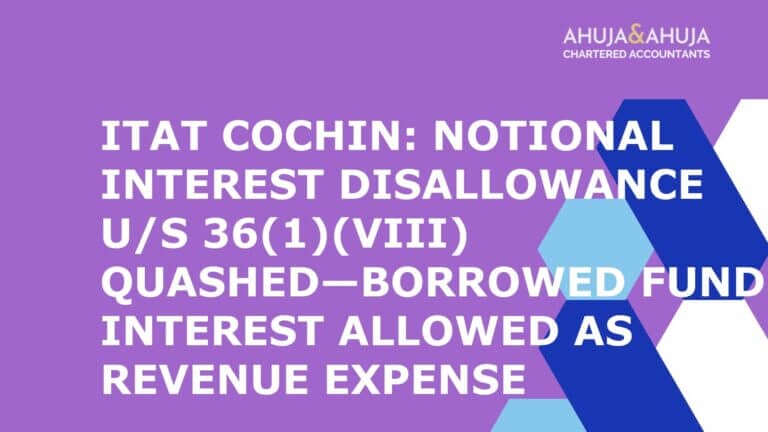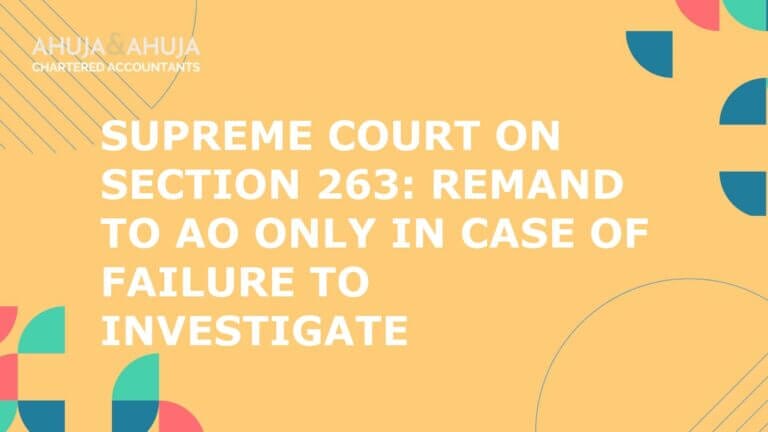Rajasthan HC: Excess Stock in Survey Taxed as Business Income, Not u/s 69
Surveys under the Income Tax Act often unearth unaccounted stock, leaving both businesses and tax professionals grappling with a crucial question: Should such excess stock be taxed as regular business income, or as unexplained investment under Section 69, which carries harsher tax and penalty consequences? The Rajasthan High Court’s decision in Pr. CIT vs. Bajargan Traders (2017) provides a landmark answer, tilting the scales in favour of business taxpayers—provided certain conditions are met.
This article unpacks the legal reasoning, practical implications, and compliance strategies arising from this judgment, offering clear guidance for CAs, business owners, and tax advisors. For businesses seeking expert assistance, consulting chartered accountants in Jodhpur can be beneficial.
Factual Matrix and Litigation Trajectory
Who, What, and How Much
Bajargan Traders, a partnership firm engaged in the trade of rice and foodgrains, was subjected to a survey by the Income Tax Department. During this exercise, officials discovered excess stock of rice valued at Rs. 70,04,814 that was not recorded in the firm’s books. The Assessing Officer (AO) treated this as unexplained investment, invoking Section 69, and taxed it under the head “income from other sources.” The Commissioner of Income Tax (Appeals) [CIT(A)] upheld this view.
However, the Income Tax Appellate Tribunal (ITAT) reversed the lower authorities, holding that the excess stock was integrally linked to the business and should be taxed as “business income.” The Revenue challenged this before the Rajasthan High Court.
Legal Reasoning: Business Income vs. Section 69 Unexplained Investment
How Did the Court Decide
The Rajasthan High Court sided with the Tribunal, affirming that the excess stock found during the survey was part and parcel of Bajargan Traders’ regular business. The Court’s reasoning rested on several pillars:
- Nature of the Asset: The excess stock (rice) was the very commodity in which the assessee regularly traded. It was not a separate investment or asset unrelated to business activity.
- Accounting Treatment: The assessee had, post-survey, incorporated the excess stock into its books by debiting purchases and crediting undisclosed income, ensuring the stock was reflected in both purchases and closing stock.
- Business Linkage: The Court emphasised that when the source of the asset is clearly linked to business activity, and the asset itself is indistinguishable from regular stock, it should be taxed as business income—not as unexplained investment under Section 69.
The High Court drew support from the ITAT’s reliance on earlier decisions, including Choksi Hiralal Mangnlal and Ramnarayan Birla, which established that if the asset is inseparable from business stock, the first attempt should be to tax it as business income. Only if the asset is unidentifiable or unrelated to business should Section 69 be invoked.
Statutory and Interpretative Framework
Section 69 is a deeming provision, designed to tax investments or assets whose source is unexplained and not recorded in the books. However, if the asset in question is clearly part of the business and its source can be reasonably linked to business activity, the law and judicial precedents favour treating it as business income. This approach allows for normal business deductions and avoids the punitive consequences of Section 69.
Distinguishing the Gujarat HC’s Fakir Mohd. Hazi Hasan
The Revenue relied on the Gujarat High Court’s decision in Fakir Mohd. Hazi Hasan, which held that unexplained assets should be taxed under Section 69. However, the Rajasthan High Court clarified that Fakir Mohd. applies only when the asset is not linked to business activity or its source is unidentifiable. In Bajargan Traders’ case, the excess rice was part of the regular trading stock, making Section 69 inapplicable.
Accounting and Financial Reporting Implications
How Should Businesses Regularise Excess Stock
The judgment provides a clear roadmap for businesses:
- Book Entry Protocol: The excess stock should be brought into the books by debiting purchases and crediting undisclosed income. This ensures the stock is reflected in both the profit and loss account and the closing stock.
- Impact on Profit and Loss: The regularisation of stock increases purchases and closing stock, but also recognises the corresponding income, ensuring transparency.
- Subsequent Sales: When the regularised stock is sold, the profit or loss is taxed as business income in the normal course.
Proper disclosure in financial statements and tax returns is essential. Businesses should clearly note the regularisation of excess stock and the corresponding tax treatment to avoid future disputes. For guidance on tax return filing and compliance, consulting income tax return filing services is recommended.
Comparative Analysis: Tax Consequences and Penalty Exposure
Why the Head of Income Matters
The distinction between taxing excess stock as “business income” versus as unexplained investment under Section 69 is not just academic—it has real financial consequences:
Business Income Treatment:
- Deductions Allowed: Normal business deductions (like partner remuneration, interest on capital, and other business expenses) can be claimed against this income.
- Lower Penalty Risk: Since the income is regularised and disclosed, penalty exposure under sections like 271(1)(c) is reduced, provided there is no concealment or misrepresentation.
- Set-Offs Permitted: Losses and other eligible set-offs under the business head can be adjusted.
Section 69 Treatment:
- No Deductions: Income is taxed on a gross basis—no business expenses or set-offs allowed.
- Higher Penalties: Section 69 is often accompanied by higher penalty and interest exposure, as it is treated as “deemed income” from unexplained sources.
- Tax Rate Impact: Tax is applicable @60% under section 115BBE
Illustrative Scenario:
Suppose a firm surrenders Rs. 70 lakh as excess stock. If taxed as business income, after claiming eligible deductions, the net taxable amount could be significantly lower than if the entire Rs. 70 lakh is taxed under Section 69 with no deductions.
Scope of the Judicial Precedent: Applicability and Limits
When Does This Ruling Apply
- Direct Business Linkage Required: The asset (excess stock) must be clearly and integrally linked to the regular business activity. For Bajargan Traders, the excess rice was the same commodity as their trading stock.
- Not a Blanket Rule: If the unaccounted asset is not part of regular inventory—say, land, jewellery (for a non-jeweller), or investments—Section 69 may still apply.
- Judicial Scrutiny Remains: Each case will turn on its facts. The onus is on the assessee to demonstrate the business nexus.
If you are looking for expert advice in tax litigation and compliance, leveraging income tax litigation services can provide significant value.
Documentation and Evidence: Establishing the Business Nexus
What Should Businesses Maintain
- Stock Registers and Inventory Records: Up-to-date and reconciled stock records are the first line of defence.
- Purchase and Sales Invoices: These help establish the flow of goods and link excess stock to business activity.
- Survey Statements and Management Representations: Consistent explanations during survey and in subsequent proceedings strengthen the case.
- Audit Trails: Regular internal audits and reconciliations can pre-empt disputes.
Practical Tip:
Maintain a documentation checklist and ensure all entries—especially those made post-survey—are supported by clear, contemporaneous records. For professional audit assistance, stock audit services may be helpful.
Synthesis with Precedents: Hierarchy of Judicial Principles
How Does This Fit with Other Key Judgments?
- Fakir Mohd. Hazi Hasan (Gujarat HC): Section 69 applies when the asset is not linked to business or its source is unidentifiable.
- Choksi Hiralal Mangnlal (ITAT): If the asset is inseparable from business stock, tax as business income first.
- Ramnarayan Birla (ITAT): Reinforces the principle that business linkage is the deciding factor.
Recommended Approach for Practitioners:
- Identify the asset and its nature.
- Establish clear business linkage.
- Use Section 69 only as a fallback if the asset is unrelated or source is untraceable.
Business Deductions, Set-Offs & Tax Planning
Maximising Legitimate Tax Benefits
- Deductions Allowed: Once excess stock is taxed as business income, all regular business deductions (including partner remuneration and interest) are available, subject to the Act’s limits.
- Commercial Expediency: Courts have repeatedly held that the Revenue cannot question the commercial wisdom of business decisions if they are bona fide and documented.
- Tax Planning: Timely regularisation and disclosure of unaccounted stock can help optimise tax liability and avoid future disputes.
For comprehensive assistance in tax planning and optimisation, consider expert finance services.
Practical Steps for Regularising Unaccounted Stock and Disclosure
What Should Businesses Do Post-Survey
- Book Entry Protocol: Debit purchases and credit undisclosed income to bring excess stock into the books.
- Inventory Alignment: Update stock records to reflect the regularised quantity and value.
- Tax Return Disclosure: Clearly disclose the adjustment in the tax return and, if required, in the audit report.
- Communication with Authorities: Proactive and transparent communication with the tax department can pre-empt unnecessary litigation.
For hands-on support, firms in regions like chartered accountants in Chandigarh offer local expertise in compliance and audit services.
Residual Risks: Revenue’s Right to Further Inquiry
Is the Matter Closed After Classification as Business Income
- Source of Funds Inquiry: While the High Court’s decision limits the scope for Section 69, the Revenue may still inquire into the source of funds if there are suspicious circumstances.
- Boundaries Set by Judgment: If the business linkage is clear and the asset is regularised transparently, further inquiry is less likely to succeed.
- Responding to Notices: Maintain all supporting documentation and be prepared to explain the business nexus if questioned.
Key Compliance Takeaways for Businesses and Tax Advisors
- Prioritise Documentation: Robust records are your best defence.
- Link Assets to Business: Always be able to demonstrate how excess stock or assets relate to regular business activity.
- Regular Reconciliation: Periodic stock audits and reconciliations can catch discrepancies early.
- Transparent Disclosure: Proactive, clear disclosure in financial statements and tax returns minimises risk.
- Stay Updated: Monitor judicial developments, as the law in this area continues to evolve.
Conclusion
The Rajasthan High Court’s decision in Pr. CIT vs. Bajargan Traders marks a significant shift in favour of business taxpayers—provided they can establish a clear business nexus for excess stock found during surveys. By treating such stock as business income, businesses can claim regular deductions, reduce penalty exposure, and ensure fairer tax treatment. However, this benefit comes with the responsibility of maintaining robust documentation and transparent accounting practices.
As tax authorities and courts continue to refine the boundaries of Section 69 and business income, practitioners should stay vigilant, adapt their compliance strategies, and prioritise proactive disclosure. For businesses, the message is clear: link your assets to your business, document everything, and regularise promptly to minimise risk.
If you have further questions or need tailored advice on handling survey findings or regularising unaccounted stock, feel free to reach out. Staying compliant is not just about following the law—it’s about being prepared for tomorrow’s scrutiny, today.
Disclaimer
The materials provided herein are solely for educational and informational purposes. No attorney/professional-client relationship is created when you access or use the site or the materials. The information presented on this site does not constitute legal or professional advice and should not be relied upon for such purposes or used as a substitute for professional or legal advice.







